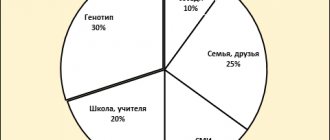Article views: 1,079
Nowadays on the streets, especially in megalopolises and large cities, you can see unusual-looking young people. Bizarre hairstyles, frightening makeup, long black clothes, tunnels in the ears, an abundance of piercings and tattoos, flashy pink tones - sometimes, looking at them, it seems that the heroes of famous Gothic novels, vampire sagas, anime cartoons or paintings have come to life before the viewer. cyberpunk style. Most often, youth subcultures are behind this.
It is worth admitting that such people greatly enliven the general flow of passers-by. It is usually difficult not to notice them. After all, a shocking appearance is one of the most striking ways of self-expression of a representative of a particular subculture. And the 20th century gave humanity various informal associations that differed from the majority in clothing style, behavior, social values and priorities.
What are youth subcultures? What is their influence on the minds and development of the younger generation? Why do children become “informal” - goths, emo, punks, skinheads or bikers? What danger lies in belonging to a particular subculture, are they harmful or beneficial? Should parents worry if their child suddenly finds himself in such a motley company? This will be discussed in this article.
Subculture is...
The word itself to designate this social phenomenon came into the Russian language from English by tracing. It’s easy to disassemble Subculture into two components: sub is a native Latin root, an analogue of our “under”, but culture is not difficult to translate.
Thus, a subculture is a “ subculture ”. The term is officially accepted by sociological, anthropological and cultural sciences. Its general interpretation is as follows:
A subculture is a part of a society’s culture that differs in behavior from the prevailing majority. It includes social groups of adherents (how is that?) of this culture.
This concept was first used by David Riesman, a famous lawyer and sociologist from the States. This happened in 1950.
Explaining what a subculture is, he talked about groups of people who deliberately choose values, style, and behavior that are different from the generally accepted ones.
These are individuals who deliberately join the minority because they do not accept the standards of the society in which they live.
In order for a certain social phenomenon that has ideological followers in the form of a clearly defined or conditional social group to be called a subculture, the difference from the dominant culture must be significant. It could be:
- another ideology
- Lifestyle,
- behavior,
- system of values,
- manner of dressing,
- language (slang, sociolect, argot),
- other elements of the same order.
It is important to understand that the main aspects here are ideological, psychological, ideological. Forming your own slang, way of dressing, cliche behavior - all this is only a consequence and a way to show another representative of your group: “ I belong !”
The term "subculture" has historical synonyms that were gradually replaced. Thus, Michel Maffesoli (France) used the combination “urban tribes” when talking about youth groups. Viktor Dolnik (Russia) called them “clubs”.
In the Soviet Union, groups representing youth subcultures were called “Informal Youth Associations.” informals came into use .
Finally, the slang concept of “party” can be used to designate a specific “cell” within a “subculture”.
Subculture of the skilled working class - fashion
The group of mods included teenagers who, after graduating from school, mastered working professions that required a high level of preparedness. In reality, a fashionist, in the ideal sense, was supposed to live luxuriously, visit prestigious and expensive clubs, restaurants and shops, and dress in extremely expensive things. But for many such pleasures were unavailable, so all that was left was to try to recreate the ideal image. There are four types of mods:
- Aggressive type in jeans and rough shoes.
- Owners of scooters, also in jeans and jackets with a hood.
- Mods in suits and polished shoes made up the majority of this subculture. The list is completed by fashion girls, exemplary in appearance and with short hair.
- Art school students, students, and so on.
Types and examples of subcultures
It is quite difficult to classify this phenomenon; at the moment there are no ready-made studies. professional and youth are often distinguished among them .
They say that teachers have their own “subculture”, because their lifestyle and sociolect may differ from the generally accepted one. And so in any profession.
IMHO (what does this mean?), this is far-fetched: such a division really exists in linguistics when we talk about various slangs, and, apparently, by analogy it was transferred to this area. But can we say that teachers deliberately violate socially accepted norms? Hardly.
But it is more than correct to highlight youth subcultures.
Most different trends have always arisen in the circles of young people and teenagers. This is not surprising, because age itself pushes one to self-expression, rebellion, to express oneself in a way that is contrary to what is generally accepted.
However, this is a kind of super class. It doesn't have an antagonist (who is it?) like old man subcultures (although the grannies on the benches are definitely hiding something).
Youth subcultures include almost all current ideological groups. Therefore, in further division, in each case it is worth remembering that this is, to one degree or another, a youth subculture as well.
It is impossible to provide a complete list of subcultures that have existed in history or exist now.
If we make an attempt at classification, then the basis for differentiation (what is it?) must be taken from the phenomenon that served as the impetus for the unification of people. Then we get these types of subcultures.
LiveInternetLiveInternet
There have been an infinite number of youth movements over the past 40 years, and each of them cannot be specifically attributed to any type of division, because each of them includes elements of the others, but still I tried to more or less systematize them. Let us highlight three areas of youth counterculture:
1. Anarcho-nihilistic - extremist subcultures of the “left” and “right” persuasion, which can also be called radically destructive. These include: Punks (from the English Punk - garbage, rot, something unnecessary). The standard punk hairstyle is considered to be a “mohawk” - a strip of long, vertical hair on a cropped head, but shaved half of the head with long hair and even just shaved temples with long hair are also common. Punks prefer torn, dirty clothes. You can often see a punk in jeans, where strips of fabric alternate with holes secured with pins and chains (in general, Punks’ love for safety pins is extremely great; they are inserted everywhere - in jackets, T-shirts, jeans and even in their ears). For footwear, punks mostly wear high combat boots. The founder of punk culture is considered to be the English group “Sex pistols”. Besides her, “Ramones” and “Dead Kenedies” are held in high esteem. In the mid-80s, the group “Exployted” appeared, which played hard punk, which was called “hardrock” and became an independent musical style. In Russia, prominent representatives of punk are Siberian groups (the most famous is “Civil Defense”, whose fans have formed an independent movement - the Letov punks, named after the founder of the group, Yegor Letov). The punk ideology is quite close to the hippie one in everything related to the disregard for material values, however, if the hippie idea is expressed as “why have money, the world is already infinitely beautiful”, then for the Punks it is more likely “the world is still g...o and nothing will help it " Unlike hippies, punks are quite aggressive in their political leanings and are considered anarchists.
Skinheads - (from the English Skin head - shaven-headed, lit. Skin-head). They listen to the “oh” style, which is extremely close to hardrock (hard punk). Appearance: True to their self-name, skins stand out primarily due to their clean-shaven head. The skin's standard attire is high combat boots, camouflage pants or high-rolled jeans with suspenders and another jacket ("bomber"). Ideology: almost all Russian skins profess extremely aggressive nationalism and racism. The ideal regime is German National Socialism. In the West, there are “sharps”, “sharp-skins” (from the English Sharp - sharp, sharp), acting under the slogan “skins against racial prejudice” and being an extreme left, pro-communist ex-peremist organization, also “gay skins” (from the English . Gay - homosexual), although ordinary skins hate sexual minorities even more than racial ones. Frequent entertainment for skins is fights with African Americans in the vicinity of the Patrice Lumumba People's Friendship University, as well as beating up representatives of other national and racial minorities wherever they meet. In addition, most skins, especially young ones (“pioneers”), are fans of some football (hockey) club. They are united in groups and often play matches of their favorite team, where they start fights with fans of other clubs. The most famous fan groups in Moscow are: “Flint's crew” and “Gladiators” (Spartak), “Red Blue Warrions” (CSKA), “Blue White Dinamite” (Dynamo), and in St. Petersburg - “Nevsky Front”.
Metalheads are fans of metal. In their opinion, there are at least three main directions of “metal” (in fact, much more): thrash, doom and dead (from the English thrash - to beat, doom rock, fate and dead - dead man, respectively) and, therefore, thrashers, doomers and dead metalheads. Appearance: virtually the same as bikers. Of all the colors, black is preferred. Metalheads of the late 80s and early 90s were characterized by the presence of a large number of metal rivets and chains in their clothes. Ideology: Of all the movements, metalheads are the least ideological. In some ways they are close to punks, but without contempt for material values. Gopniks are a community uncontrolled by organized crime or controlled to a lesser extent. They quickly proved themselves to be the “cultural enemies” of most youth subcultures: bikers, ravers, roller skaters, etc. Any teenager, not only those belonging to a different subculture, can be beaten, sexually assaulted, or robbed. The confrontation between youth gangs also has not become a thing of history, but has moved to the periphery.
Football fans - A group close to criminal subcultures consists of fans (fans) of football teams. Football fans are a complex community to organize. Among the fans of the Moscow “Spartak”, in particular, such groups as “Red White Hooligans”, “Gladiators”, “Eastern Front”, “Northern Front”, etc. stand out. The group that maintains control over the entire community is the “right” . It consists mainly of young people who have served in the army. The “rightists” go to all the team’s matches, their main function is to run the stadium, organize the reaction of the fans (“wave”, etc.), but also to command “military actions” - battles with fans of hostile teams and the police. Travel to other cities is very often associated with fights - often on the station square. In general, the hooligan mass of young people is well controlled by the leaders (leaders) from the “Right”.
Hackers - this term refers to all network hackers, creators of computer viruses and other computer criminals, such as carders (use someone else's credit card), crackers (hacking a security system (in particular software security, creating cracks), script-kiddies (use everything ready-made , the most common vulnerabilities, available exploits, he himself does not know how to find a vulnerability or write an exploit (a fragment of program code that uses the opportunities provided by an error). Many computer crackers can rightfully be called hackers, because they really correspond to all (or almost all) of the above definitions of the word “hacker". Of course, not all computer hackers (and, especially, criminals) can call themselves hackers. In Russia, Europe and America, computer hacking, destruction of information, creation and distribution of computer viruses and malware are punishable by law. Malicious hackers, according to international laws against cybercrime, are subject to extradition like war criminals.
Satanists - Its origins lie in the 1950s, when La Vey founded a community that practiced a combination of magic (as psychodrama) and hedonistic egoistic philosophy. LaVey himself admitted that the formation of his worldview was influenced by the works of Friedrich Nietzsche, Ragnar Redbeard, Nicolo Machiavelli, Jack London, and the biographies of such famous personalities as Vasily Zaharoff, Count Cagliostro and Grigory Rasputin. Later, having accumulated enough material and experience, Anton LaVey came to the conclusion that in order to achieve some changes in the world, just another philosophy is not enough; official recognition of a non-standard worldview is necessary as a religion, which he called Satanism. In 1966, LaVey founded the Church of Satan, and three years later, in 1969, he published The Satanic Bible, which describes the basics of the Satanic worldview - the refusal to worship anything or anyone (in other words, Satanism is not a “cult of evil” ); the need for personal development (Satanism is positioned as a worldview of independent individuals - capable of making informed choices); a departure from the dogmas of Christian or other considered as traditional morality (which nevertheless does not imply committing any violent actions against the church - as long as these actions do not seem to be the most reasonable and appropriate behavior in a given situation: a Satanist can do anything, but far from not everything is reasonable; “everything is possible, but not everything is useful”).
2. Romantic-escapist subcultures - they are distinguished by a certain worldview and way of life, and involve the emancipation of the unconscious, including with the help of drugs; violation of public decency. Hippie - ideology - a person should be free, first of all, internally. Man is also free in love, which promotes the unity of people. They preach pacifism: they call not to respond to violence with violence, they oppose military service. They believe in a higher reality that exists alongside the everyday one in which we all live. You can reach it through a change in consciousness through art. Hence the interest in religion and creative activity. The desire for naturalness is expressed in the desire not to change what happens by itself (for example, not to cut hair), not to carry out active, purposeful actions, to be inactive, to be unpretentious in everyday life, to be able to endure adversity and deprivation. Hippies are romantics, they love everything bright, original, and creative. They want to be independent from social conventions, free individuals. To emancipate one's consciousness and feel freedom, smoking hashish and using LSD are common among hippies. They are interested in the philosophy of the East. Among the musical movements they prefer soft rock, in particular in Russia the group “Aquarium”, and ethnic music of different nations. In the West, the icons were The Doors, Jefferson Airplane, etc.
Indianists - they study the cultures of the Indians, mainly North American, striving for an accurate reproduction of their customs and rituals. Something between an American Indian club and a religious-mystical movement. With all the “ethnographic” attributes of the Indian subculture, its values: collectivism (community), environmentalism, cosmism, echo traditional Russian values. In the 70s - early 80s. Kazan was one of the centers of the emerging Indianist movement and Indianist subculture. Later, the initiative passed to more numerous and energetic groups of Indianists in Leningrad and Moscow. The peak of the Indianist movement occurred in 1985-90. By now it has been passed, and in Kazan Indianists are represented by a little more than a dozen people. They are not closed, but they are of little interest in contacts with representatives of other youth subcultures of Indianists. Tolkienists and roleplayers in general (role-playing game enthusiasts) were originally part of the hippie subculture, but recently their movement has grown so much that they have begun to include many non-hippies in their ranks. Tolkienists are fans of the famous English philologist and writer John Ronald Reuel Tolkien, (in Tolkienist slang - Professor), he was born in 1892 and died in 1973. Books by J.R.R. Tolkien's "The Lord of the Rings", "Silmarion" and others belong to the fantasy genre - fairy-tale fiction. Tolkien created in his works the magical world of Middle-earth, inhabited by wonderful creatures, some of which were borrowed by him from the folklore of various peoples of the world (elves, trolls, gnomes, etc.), others were invented by the writer (for example, hobbits, a hybrid of a human and a rabbit ), each with its own history, geography and even the beginnings of its own language (say, Elvish). Tolkienists get used to this world, imagining themselves as its inhabitants. Hence the unusual patterns of behavior in everyday life. Thus, a Tolkienist who considers himself an elf tries to behave as he thinks a real elf would act. During games (“hichek” in Tolkien jargon), a group of young people goes into the forest, where, having assigned roles, they act out scenes from Tolkien’s works. Within itself, the movement is divided into two tensions: representatives of the first prefer to act out scenes from the book, without changing anything in the plot, supporters of the other take only basic data (names and characters of the characters, time, place and goals of the action) and present a real competition where you need to run well , jump, swim, fight with swords, navigate the terrain.
Goths are a movement that originated in the late 70s of the 20th century on the wave of post-punk. The gothic subculture is very diverse and heterogeneous, but it is, to one degree or another, characterized by the following features: a gloomy image, there may be an interest in mysticism and esotericism, decadence, a love of horror literature and films, a love of gothic music (gothic rock, gothic -metal, death rock, darkwave, etc.). The Gothic worldview can be characterized as a tendency to a “dark” perception of the world, a certain romantic-depressive outlook on life, reflected in behavior (isolation, frequent depression, melancholy, increased vulnerability), perception of reality (misanthropy, a refined sense of beauty, addiction to the supernatural) , relations with society (rejection of stereotypes, standards of behavior and appearance, antagonism with society, isolation from it), semi-romantic perception of death. Also characteristic of the Goths are “artistry” and the desire for self-expression (manifested in working on one’s own appearance, creating poetry, painting, and other types of creativity). However, they are divided into two types. A part of the Goths (usually a smaller one), often called “Mopey Goths” in the West, are characterized by an emphatically serious attitude towards the “Gothic worldview”, but the majority (the so-called “Perky Goths”) take the subculture less “seriously”. They are attracted by the aesthetic side of the subculture, the possibilities of self-expression, and certain aspects of the Gothic worldview, but they do not put it “at the forefront.” There is a certain confrontation between these views on the Gothic subculture, which, however, does not lead to any significant changes in the structure of the Gothic subculture.
Emo - (English emo: from emotional - emotional) is a youth subculture formed on the basis of fans of the musical style of the same name. Its representatives are called Emo-kids (emo + English kid - young man; child) or, depending on gender: emo-boy (English boy - boy, guy), emo-girl (English girl - girl, girl) . Emo is characterized by a fundamentally infantile view of the world, introversion, and an emphasis on internal experiences, based on the aesthetics of beauty. There is a stereotypical idea of emos as whiny boys and girls. Despite the fact that emo rock appeared and developed as a subtype of punk rock, the value orientations of these subcultures are completely different. Emo culture is completely devoid of the aggressive machismo so characteristic of hard rock, the direct ancestor of emo. Emo culture promotes Strayed-Edge, that is, a healthy lifestyle: abstinence from tobacco, drugs and alcohol, and choosiness in sexual relations. However, only a minority of emo people follow these rules. Great importance is attached to such values as friendship and love. They are placed on a pedestal among other phenomena of life. The spiritual ideals of culture are truthfulness, honesty, fidelity, sincerity. The traditional emo hairstyle is considered to be oblique, torn bangs to the tip of the nose, covering one eye, and short hair sticking out in different directions at the back. Both boys and girls can paint their lips to match their skin color and use a light foundation. The eyes are heavily lined with pencil or mascara, making them look like a bright spot on the face. Nails are covered with black varnish. Emos wear pink and black clothing with two-tone patterns and stylized badges. The main colors in clothing are black and pink (purple), although other shockingly bright combinations are considered acceptable. Many of them are into anime and try to look like perfect manga drawings. Among many youth subcultures, there is a hostile attitude towards “emo”, which is expressed in ridicule of appearance, criticism of the ideas and musical preferences of emo kids.
3. Hedonistic-entertaining: Bikers - (from the English colloquial Bike - bicycle, motorcycle), who, with the light hand of Soviet propaganda, were often called rockers. However, almost all rock fans consider themselves rockers - punks, metalheads and many others. Therefore, this definition cannot be considered correct. Listen to hard rock. In general, bikers are distinguished by a fairly wide variety of musical tastes, which is noticeable at least from the bike show held annually in the Moscow region, where performers who are completely different from each other perform: Garik Sukachev and the group “Malchishnik”, “Time Out” and “IFK”. The main concept in biker ideology is the motorcycle. The whole world is divided into those who move on it, and those who prefer any other method, and the latter do not arouse any interest in themselves among bikers.
Ravers - (from the English Rave - nonsense, incoherent speech) originated in the USA and Great Britain. Distributed in Russia since 1990-91. Musically, the rave style is a successor to the techno and acid house styles. An integral part of the raver lifestyle is night discos with powerful sound, computer graphics, and laser beams. Ravers' clothing is characterized by bright colors and the use of artificial materials (vinyl, plastic). The basic values that underlie this subculture: an easy, carefree attitude to life, the desire to live for today, to be dressed in the latest fashion... The development of the rave subculture went in parallel with the spread of drugs, in particular ecstasy. Taking hallucinogens for the purpose of “expanding consciousness” has, unfortunately, become an almost integral part of the raver subculture. At the same time, many youth culture figures, including DJs - key figures in the rave subculture - have expressed and continue to express an extremely negative attitude towards drug use.
Rastafarians - appeared in the early 1990s, they are often not true adherents of the original religious and political doctrine of African superiority, but consider themselves to be in this group primarily based on the use of marijuana and hashish. For some, this is enough to consider themselves Rastafarians, some are closer to the Rastafarian concept - many listen to Bob Marley, SKA and reggae music. In general, they use a combination of colors “red-yellow-green” for identification (for example, in clothes), and they wear dreadlocks. However, few people sincerely advocate for the return of American blacks to Africa. Now in Moscow, St. Petersburg and other cities there are quite large Rastafarian communities that hold cultural events (usually concerts or festivals), maintain websites, and publish media materials. Almost all Russian reggae groups consider themselves Rastafarians - at least they use characteristic symbols and revere Bob Marley (at the same time, Rastafarianism is an extremely diverse culture with many varieties, and some orthodox Rastafarians have a negative attitude towards reggae music because of its commercialization, and some do not smoke marijuana; there are also Rastafarian politicians, for example, New Zealand MP Nandor Tantsosh).
Rappers, break dancers, graffiti artists - listen to rap. Russian rappers dress like black American rappers (mostly sporty style with a predominance of bright colors), borrow many words from them and sometimes even give themselves hairstyles characteristic only of African Americans. The rap subculture largely overlaps with the subcultures of roller skaters and skateboarders, as many roller skaters and skateboarders listen to rap, and rappers roller skate and skateboard. However, the same applies to almost all modern subcultures.
Majors, glamorists - The English word glamor arose in the Middle Ages as a variant of grammar “grammar”, “book”, borrowed from French. grammaire (the development of meanings is as follows: grammar → complex book → book of spells → witchcraft, spells → enchantment, enchantment; cf. also French grimoire, Russian grimoire “book of spells”, of the same origin). It is applied primarily to people who suffer from the pursuit of fashion, fashion for clothes and cosmetics, and in extended use - also to lifestyle, entertainment, and so on. “Glamourous” usually refers to standards of clothing and life advertised in “women’s” and “men’s” glossy magazines (the concepts of “glossy magazine” and “glamor magazine”, “glamour” and “gloss” are often used interchangeably).
Personally, I cannot firmly identify myself with any of these areas of social expression, but I am close to hippies, goths and emo, and maybe even partly to Rastafarians, but where would you classify yourself or classify yourself?
Musical subcultures
Music genres are the foundation on which the loudest, most widely known subcultures were built. First of all, this:
- Hippie. One of the oldest youth musical subcultures, which united adherents of the idea of pacifism and rock lovers.
- Rastafarians. Fans of reggae and the legalization of marijuana, whose subculture has received the status of a religious movement (Rastafarianism).
- Metalheads – lovers of metal music. One of the first representatives of a new wave of vibrant subcultures that appeared in the 1970s and 80s. The most important thing is personal freedom.
- Punks. In addition to their love for punk rock, they are united by pure opposition to society, by rabid political rebellion. “Mom - anarchy, dad - a glass of port” - this goes here.
- Goths. Gloomy, melancholic individuals who listen to gothic rock and trudge through the Victorian era.
- Hip-hop culture. Inside, rap, hip-hop and beatbox are distinguished.
- Emo opened a new era of subcultures that opened in the 90s and 2000s.
These are mainly teenagers who demonstrate sensitivity, vivid emotions and a desire for suicide. The musical style is called the same.
What attracts young people to subcultures
Youth subcultures on a personal level are a way to achieve self-esteem and compensate for the negative attitude of others towards oneself. Dissatisfaction with one’s own style of behavior, body, inconsistency with the standards of femininity or masculinity. Subcultures, the list of which is huge and varied, allow teenagers to give themselves an aura of specialness and bright individuality.
Social and psychological reasons are considered to be the attractiveness of an informal lifestyle, which does not require responsibility, focus and dedication, in contrast to generally accepted requirements in society. There are three possible consequences of the influence of the subculture on the socialization of youth:
- A positive orientation, which manifests itself in social and cultural self-determination, creative self-realization and experimentation with images, behavioral style, and so on.
- Socially negative orientation, which is found in joining subcultures of a criminal, extremist nature, drugs and alcohol.
- An individually negative tendency manifests itself in escaping reality, justifying one’s infantile behavior, and avoiding cultural and social self-determination.
It is quite difficult to determine which trends predominate in a particular subculture. It is even more difficult to notice how it affects a person’s lifestyle. Modern trends attract young people with their diversity and provocative appearance and behavior. But it is worth noting that belonging to a certain social group is, as a rule, a short-term phenomenon. Basically, the passion for subcultures begins at the age of 13 and goes away by the age of 19. By this age, a person changes his hobbies or rethinks his life values. But there are exceptions in terms of age, for example, the rocker subculture has no time restrictions. Among the representatives of this community you can also find mature people, and sometimes even elderly people. They have remained true to their teenage hobbies and still listen to rock or play in bands. As a rule, the rocker subculture includes those people who, even in adulthood, are not ready for a responsible and independent life.
The characteristics of adolescent subcultures include their inconstancy in behavior. Many teenagers have an unstable psyche, which largely depends on how their relationship with their parents develops. If there is distance in relationships with close people, then the chances that the child will come under outside influence increase. After all, a teenager needs communication, advice and understanding. If he does not receive all this in his family, then he will seek support among people who are close in spirit and moral state. Very often, a child’s deviant behavior in adolescence is associated with a bad example from the outside. This could be television, bad actions of comrades in the company, etc. In order to prevent a negative influence on the child, parents need to establish contact with him or attract older youth for this purpose.
Urban subcultures
These are what we can rightly call “urban tribes.” These include:
- Roofers . They explore abandoned buildings, old industrial or social facilities. They also climb onto the roofs of high-rise buildings.
- Diggers . They travel through underground passages and structures.
- Cybergoths , also known as cyberpunks (see what steampunk is). Genesis of books and games. These are fans of the idea of a man-made apocalypse and life after it. Designed for industrialization.
- Stalkers. They travel to prohibited zones and closed areas.
Some include here hooligans who do not consider themselves a subculture.
But you can add bikers , who often find themselves outside the classifications. These are people for whom the motorcycle has become a way of life. The cult of wheels, roads and complete freedom.
Countercultures
The oldest and most established counterculture of the world of organized crime (for example, AUE), based on the concepts of thieves. It has its own hierarchy, laws, rules. Its own musical culture (thieves' song), tattoo.
Another striking example is skinheads . This counterculture has a musical genesis (from reggae and ska), but it has moved far from those roots.
Subsequently, skinheads became deeply politicized. This is how Nazis, anti-communists, etc. appeared.











